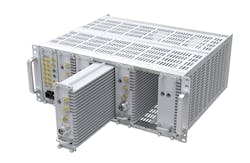How Modular Design Is Transforming Enterprise Connectivity
For years, mobile carriers funded initiatives like distributed antenna systems (DAS), repeaters, and smalls cells for their enterprise customers to improve connectivity throughout buildings. The logic was simple: In exchange for absorbing the hardware costs, enterprises would agree to equip all of their employees with a particular carrier’s devices. A building’s telecom closet served as a de facto hub for all connections, but upgrades to equipment were largely driven by, and depended entirely on, carrier initiatives. Over time, these closets grew into odd-looking bundles of unlabeled wires that carry a slight resemblance to medieval dungeons.
Today, a number of factors, such as bring your own device (BYOD), Public Safety, 5G, and the innovation bands, are propelling shifts in the telecom value chain. To be prepared, enterprises must now look for ways to future-proof their connectivity initiatives, and incorporate designs built on flexibility and modularity.
Enterprise-level BYOD programs have dramatically shifted the onus of DAS away from individual carriers. Enterprise IT now needs to identify which cell providers are most common across an employee base, and then support the frequencies and technologies of that carrier, or more likely, more than one carrier. These costs aren’t static, but instead change regularly.
For instance, some carriers are building out their network on the 600-MHz spectrum owned by the company. Prior to BYOD, it would have provided connectivity upgrades to its enterprise clients as part of its rollout plans. Today, however, it’s up to IT departments to understand the changing landscape of connectivity, and adjust to it accordingly.
Onset of Transformative Technologies
As carriers begin to roll out true 5G solutions, the number of improvement and product rollouts will increase. Mobile carriers are expanding trials throughout the U.S. (and the world), and a U.S. rollout will require most buildings to revamp their connectivity solutions to meet their employee and client needs; 80% of mobile traffic is generated in-building. The success of 5G and high-speed wireless connectivity might ultimately rely on what’s in a telecom closet, an irony that can’t be understated when discussing ubiquitous wireless coverage.
5G isn’t the only transformative near-term technology that’s about to become mainstream. Public-safety communications, those that take place between first responders such as firefighters and police departments, are undergoing change as a result of a governmental decision, namely FirstNet.
Today, in order to obtain a certificate of occupancy, buildings are required to have certain levels of connectivity available for first responders. However, the actual regulations and requirements that must be met to accept tenants can vary wildly between cities and states.
That situation is changing, though, as the U.S. Government has awarded AT&T a contract to build FirstNet, a nationwide LTE network based on 700/800-MHz spectrum that will offer interoperability between states. In practical terms, this means Nevada firefighters who assist in a California wildfire will have access to the same communications band as the California responders, which will help both work together in times of emergency.
It’s unclear as to how rapidly FirstNet will roll out, and how each regulator that currently oversees building connectivity will respond. However, the idea that jurisdictions will require blanket connectivity for first responders using AT&T’s spectrum seems likely to transpire soon. For the buildings and IT departments that handle telecom closets, this is a new wrinkle, and one that must be addressed.
There’s a third technology being utilized that also requires flexibility in design: The launch of CBRS and LAA bands for connectivity. The “innovation bands” are gaining traction in numerous ways. In many instances, enterprises utilize this unlicensed spectrum to build out their own, private wireless networks.
5G, FirstNet, and the innovation bands all point to the same thing: Support for new devices and bands will require new hardware, placing the onus on IT departments to find ways to future-proof today’s enterprise investments. The organizations that have been successful have done so by focusing their purchasing on modular solutions, those that can be expanded through simple plug and play.
The Modular Way
A modular design approach was incorporated into ADRF's ADX V Series DAS solution. (Courtesy of ADRF)
There are three guidelines that IT departments should follow when incorporating modular approaches.
- Interoperability is critical: It’s important to select hardware from vendors that offer interoperability among their peers. This ensures that telecom closets are equipped to meet an enterprise’s unique needs. For instance, not every DAS provider has support for CBRS or LAA bands, meaning that the only ways to support these bands is either to replace entire legacy systems, or find interoperable hardware. The latter offers tremendous cost savings.
- Size matters: There’s a limited amount of space in a typical telecom closet, meaning a finite number of cubic feet available for hardware. As such, the actual physical size of equipment must play a role in the decision-making process. In some instances, there are solutions available that combine various products, such as a DAS head end and repeater, into one smaller box. These products can save space and enable IT departments to maintain flexibility for the next upgrade.
- Remote control: As telecom closets become more packed, it’s important for IT and engineering teams to have oversight on how equipment is performing via some sort of remote mechanism, either web-based, or ideally, via mobile application. In addition to monitoring that includes real-time alarms, the mobile control should allow for simple and incremental adjustments, as well as additions to a network. For instance, if a company needs to install a new repeater, the mobile control should be able to recognize and activate the hardware once it’s installed.
Fortunately for IT departments, there are systems integrators who have extensive experience in the telecom markets, and can offer advice and implementation alike. These integrators should be able to share best practices on modular design, and explain how to future-proof connectivity solutions.
Connectivity is undergoing massive transition, as technologies such as 5G and private wireless networks built on LAA and CBRS take off. At the same time, enterprise IT is being asked to support a wider range of devices that all need a connection. The only way they can be successful is by incorporating a modular design into their approach.
William Wong is DAS Engineering Manager at Advanced RF Technologies Inc. (ADRF).
About the Author
William Wong - DAS Engineering
DAS Engineering Manager
William Wong is the DAS Engineering Manager at ADRF Technologies Inc., in charge of overseeing customer training and technical support of ADRF’s equipment for challenging DAS projects. He has 10 years of experience in the in-building/DAS sector and related engineering fields, including several years at a DAS integrator where he focused on survey, design, project management, and implementation and optimization of carrier and neutral host DAS. Prior to ADRF, William worked at C Squared Systems as a Senior RF Engineer and Lockheed Martin as an electrical engineer. William received his BS in Electrical Engineering from Syracuse University.


